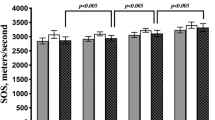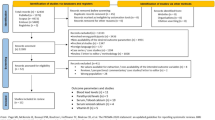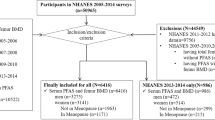Abstract
Lead accumulates in adult bones for many decades; previous studies have shown lead’s detrimental effects on osteoblast and osteoclast activity in association with bone remodeling. Osteoporosis is a disease of the bones resulting in low bone mass that induces fragile bones and hence susceptibility of fracture. We estimated the association between urinary lead (U-Pb) levels and bone health in adults participating in the third Nutrition and Health Survey in Taiwan (NAHSIT) from 2005 to 2008. A total of 398 participants were divided into normal (T-score>−1), osteopenic (T-score between −1 and −2.5), or osteoporotic (T-score<−2.5) groups according to the results of bone mineral density (BMD) measurements. Heavy metals were measured in urine specimens using inductively coupled plasma-mass spectrometry. In the multivariable logistic regression analysis, age (OR=1.08; 95% CI=1.05–1.10), former smokers (OR=2.95; 95% CI=1.22–7.11) and higher U-Pb levels than upper tertile (OR=2.30; 95% CI=1.19–4.48) were associated with osteopenia/osteoporosis. Furthermore, age (OR=1.06; 95% CI=1.02–1.10) and higher U-Pb levels (OR=2.81; 95% CI=1.13–6.97) were significantly associated with osteopenia and osteoporosis in women. These results suggest that adults, particularly in women, with higher U-Pb levels may have increased odds of osteopenia and osteoporosis.
This is a preview of subscription content, access via your institution
Access options
Subscribe to this journal
Receive 6 print issues and online access
$259.00 per year
only $43.17 per issue
Buy this article
- Purchase on Springer Link
- Instant access to full article PDF
Prices may be subject to local taxes which are calculated during checkout

Similar content being viewed by others
References
Cummings SR, Melton LJ . Epidemiology and outcomes of osteoporotic fractures. Lancet 2002; 359: 1761–1767.
Yang NP, Deng CY, Chou YJ, Chen PQ, Lin CH, Chou P et al. Estimated prevalence of osteoporosis from a Nationwide Health Insurance database in Taiwan. Health Policy 2006; 75: 329–337.
Cooper C, Melton L . Magnitude and Impact of Osteoporosis and Fractures. Osteoporosis Academic Press: San Diego. 1996, 419–434.
Lane NE . Epidemiology, etiology, and diagnosis of osteoporosis. Am J Obstet Gynecol 2006; 194: S3–S11.
Puntus T, Schneider B, Meran J, Peterlik M, Kudlacek S . Influence of age and gender on associations of body mass index with bone mineral density, bone turnover markers and circulating calcium-regulating and bone-active sex hormones. Bone 2011; 49: 824–829.
Jones LC, Mont MA, Le TB, Petri M, Hungerford DS, Wang P et al. Procoagulants and osteonecrosis. J Rheumatol 2003; 30: 783–791.
Glueck CJ, Freiberg RA, Crawford A, Gruppo R, Roy D, Tracy T et al. Secondhand smoke, hypofibrinolysis, and Legg-Perthes disease. Clin Orthop Relat Res 1998; 352: 159–167.
Lorentzon M, Mellstrom D, Haug E, Ohlsson C . Smoking is associated with lower bone mineral density and reduced cortical thickness in young men. J Clin Endocrinol Metab 2007; 92: 497–503.
Need AG, Kemp A, Giles N, Morris HA, Horowitz M, Nordin BE . Relationships between intestinal calcium absorption, serum vitamin D metabolites and smoking in postmenopausal women. Osteoporos Int 2002; 13: 83–88.
Pollack AZ, Mumford SL, Wactawski-Wende J, Yeung E, Mendola P, Mattison DR et al. Bone mineral density and blood metals in premenopausal women. Environ Res 2013; 120: 76–81.
Alfvén T, Järup L, Elinder CG . Cadmium and lead in blood in relation to low bone mineral density and tubular proteinuria. Environ Health Perspect 2002; 110: 699.
Aaseth J, Boivin G, Andersen O . Osteoporosis and trace elements—an overview. J Trace Elem Med Biol 2012; 26: 149–152.
Weisskopf MG, Jain N, Nie H, Sparrow D, Vokonas P, Schwartz J et al. A prospective study of bone lead concentration and death from all causes, cardiovascular diseases, and cancer in the Department of Veterans Affairs Normative Aging Study. Circulation 2009; 120: 1056–1064.
Fadrowski JJ, Navas-Acien A, Tellez-Plaza M, Guallar E, Weaver VM, Furth SL . Blood lead level and kidney function in US adolescents: The Third National Health and Nutrition Examination Survey. Arch Intern Med 2010; 170: 75–82.
Gerhardsson L, Attewell R, Chettle DR, Englyst V, Lundstrom NG, Nordberg GF et al. In vivo measurements of lead in bone in long-term exposed lead smelter workers. Arch Environ Health 1993; 48: 147–156.
Bergdahl IA, Stromberg U, Gerhardsson L, Schutz A, Chettle DR, Skerfving S . Lead concentrations in tibial and calcaneal bone in relation to the history of occupational lead exposure. Scand J Work Environ Health 1998; 24: 38–45.
ATSDR. Toxicological profile for lead. In: Agency for Toxic Substances and Disease Registry. U.S. Department of Health and Human Services: Atlanta, GA.. 2007.
Silbergeld EK, Schwartz J, Mahaffey K . Lead and osteoporosis: mobilization of lead from bone in postmenopausal women. Environ Res 1988; 47: 79–94.
Escribano A, Revilla M, Hernandez E, Seco C, Gonzalez-Riola J, Villa L et al. Effect of lead on bone development and bone mass: a morphometric, densitometric, and histomorphometric study in growing rats. Calcif Tissue Int 1997; 60: 200–203.
Ronis MJ, Aronson J, Gao GG, Hogue W, Skinner RA, Badger TM et al. Skeletal effects of developmental lead exposure in rats. Toxicol Sci 2001; 62: 321–329.
Campbell JR, Rosier RN, Novotny L, Puzas JE . The association between environmental lead exposure and bone density in children. Environ Health Perspect 2004; 112: 1200–1203.
Campbell JR, Auinger P . The association between blood lead levels and osteoporosis among adults—results from the third national health and nutrition examination survey (NHANES III). Environ Health Perspect 2007; 115: 1018–1022.
Sun Y, Sun D, Zhou Z, Zhu G, Zhang H, Chang X et al. Osteoporosis in a Chinese population due to occupational exposure to lead. Am J Ind Med 2008; 51: 436–442.
Fukui Y, Miki M, Ukai H, Okamoto S, Takada S, Higashikawa K et al. Urinary lead as a possible surrogate of blood lead among workers occupationally exposed to lead. Int Arch Occup Environ Health 1999; 72: 516–520.
Tsaih SW, Schwartz J, Lee ML, Amarasiriwardena C, Aro A, Sparrow D et al. The independent contribution of bone and erythrocyte lead to urinary lead among middle-aged and elderly men: the normative aging study. Environ Health Perspect 1999; 107: 391–396.
Dietary Reference Intakes [Internet]. 2013. Ministry of Health and Welfare in Taiwan: Taiwan, [update 2014; cited 2014 Octber 29]. Available from http://www.hpa.gov.tw/Bhpnet/Web/HealthTopic/TopicArticle.aspx?No=201308300011&parentid=201205100003.
Khalil N, Cauley JA, Wilson JW, Talbott EO, Morrow L, Hochberg MC et al. Relationship of blood lead levels to incident nonspine fractures and falls in older women: the study of osteoporotic fractures. J Bone Miner Res 2008; 23: 1417–1425.
Pounds JG, Long GJ, Rosen JF . Cellular and molecular toxicity of lead in bone. Environ Health Perspect 1991; 91: 17–32.
Sauk JJ, Smith T, Silbergeld EK, Fowler BA, Somerman MJ . Lead inhibits secretion of osteonectin/SPARC without significantly altering collagen or Hsp47 production in osteoblast-like ROS 17/2.8 cells. Toxicol Appl Pharmacol 1992; 116: 240–247.
Holz JD, Sheu TJ, Drissi H, Matsuzawa M, Zuscik MJ, Puzas JE . Environmental agents affect skeletal growth and development. Birth Defects Res C Embryo Today 2007; 81: 41–50.
Monir AU, Gundberg CM, Yagerman SE, van der Meulen MC, Budell WC, Boskey AL et al. The effect of lead on bone mineral properties from female adult C57/BL6 mice. Bone 2010; 47: 888–894.
Carmouche JJ, Puzas JE, Zhang X, Tiyapatanaputi P, Cory-Slechta DA, Gelein R et al. Lead exposure inhibits fracture healing and is associated with increased chondrogenesis, delay in cartilage mineralization, and a decrease in osteoprogenitor frequency. Environ Health Perspect 2005; 113: 749–755.
Beier EE, Maher JR, Sheu TJ, Cory-Slechta DA, Berger AJ, Zuscik MJ et al. Heavy metal lead exposure, osteoporotic-like phenotype in an animal model, and depression of Wnt signaling. Environ Health Perspect 2013; 121: 97–104.
Staessen JA, Roels HA, Emelianov D, Kuznetsova T, Thijs L, Vangronsveld J et al. Environmental exposure to cadmium, forearm bone density, and risk of fractures: prospective population study. Public Health and Environmental Exposure to Cadmium (PheeCad) Study Group. Lancet 1999; 353: 1140–1144.
Nawrot T, Geusens P, Nulens TS, Nemery B . Occupational cadmium exposure and calcium excretion, bone density, and osteoporosis in men. J Bone Miner Res 2010; 25: 1441–1445.
Engström A, Michaëlsson K, Vahter M, Julin B, Wolk A, Åkesson A . Associations between dietary cadmium exposure and bone mineral density and risk of osteoporosis and fractures among women. Bone 2012; 50: 1372–1378.
Nash D, Magder LS, Sherwin R, Rubin RJ, Silbergeld EK . Bone density-related predictors of blood lead level among peri- and postmenopausal women in the United States: The Third National Health and Nutrition Examination Survey, 1988-1994. Am J Epidemiol 2004; 160: 901–911.
Jackson LW, Cromer BA, Panneerselvamm A . Association between bone turnover, micronutrient intake, and blood lead levels in pre- and postmenopausal women, NHANES 1999-2002. Environ Health Perspect 2010; 118: 1590–1596.
Sakai T . Biomarkers of lead exposure. Ind Health 2000; 38: 127–142.
Tsaih SW, Korrick S, Schwartz J, Lee ML, Amarasiriwardena C, Aro A et al. Influence of bone resorption on the mobilization of lead from bone among middle-aged and elderly men: the Normative Aging Study. Environ Health Perspect 2001; 109: 995–999.
Acknowledgements
Data analyzed in this paper were collected by the research project “Nutrition and Health Survey in Taiwan” (NAHSIT) sponsored by the Department of Health in Taiwan (DOH94-fs-6-4). This research project was carried out by the Institute of Biomedical Sciences of Academia Sinica, directed by Dr Wen-Harn Pan. The Office of Nutrition Survey and The Center for Survey Research of Academia Sinica are responsible for data distribution. The assistance provided by the Institutes and aforementioned individuals is greatly appreciated. The views expressed herein are solely those of the authors.
Author information
Authors and Affiliations
Corresponding author
Ethics declarations
Competing interests
The authors declare no conflict of interest.
Additional information
Supplementary Information accompanies the paper on the Journal of Exposure Science and Environmental Epidemiology website
Supplementary information
Rights and permissions
About this article
Cite this article
Tsai, TL., Pan, WH., Chung, YT. et al. Association between urinary lead and bone health in a general population from Taiwan. J Expo Sci Environ Epidemiol 26, 481–487 (2016). https://doi.org/10.1038/jes.2015.30
Received:
Revised:
Accepted:
Published:
Issue Date:
DOI: https://doi.org/10.1038/jes.2015.30
Keywords
This article is cited by
-
Associations of multiple plasma metals with osteoporosis: findings from the Dongfeng-Tongji cohort
Environmental Science and Pollution Research (2023)
-
Potential roles of gut microbiota in metal mixture and bone mineral density and osteoporosis risk association: an epidemiologic study in Wuhan
Environmental Science and Pollution Research (2023)
-
Cosmetic use and serum level of lead (not cadmium) affect bone mineral density among young Iranian women
Environmental Science and Pollution Research (2022)
-
Exposure to heavy metals and the risk of osteopenia or osteoporosis: a systematic review and meta-analysis
Osteoporosis International (2020)
-
Levels and temporal variations of urinary lead, cadmium, cobalt, and copper exposure in the general population of Taiwan
Environmental Science and Pollution Research (2019)



